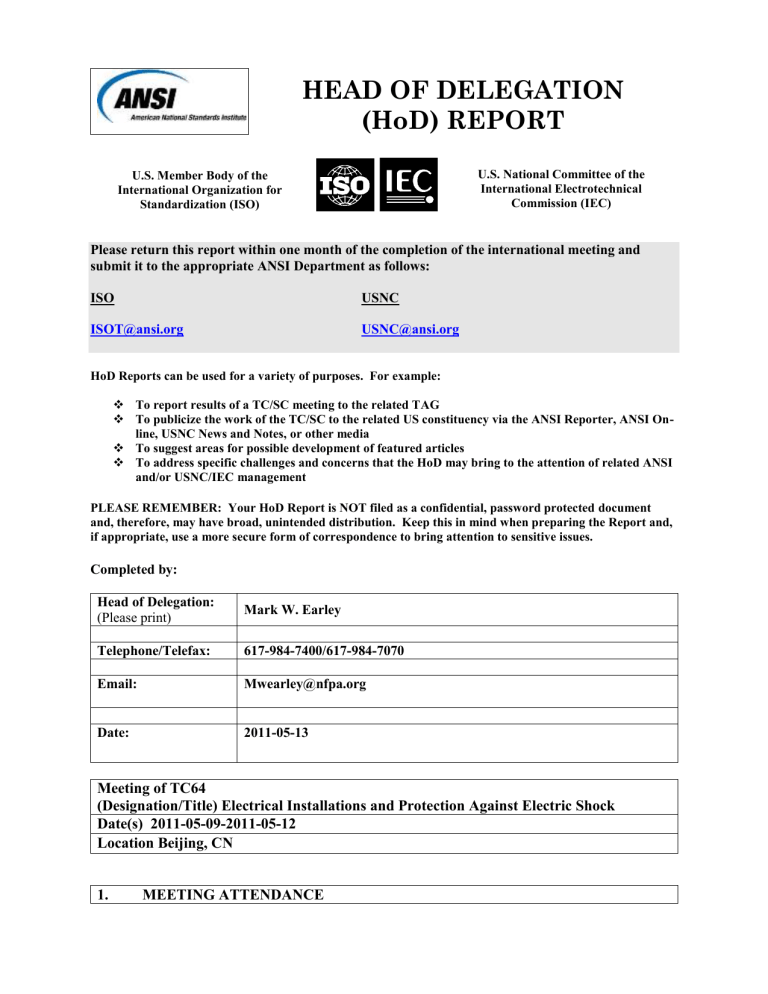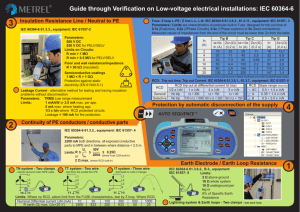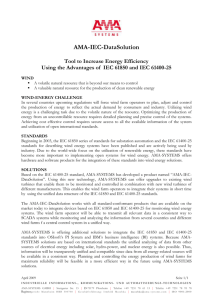hod report iec tc 64 meeting held in beijing

HEAD OF DELEGATION
(HoD) REPORT
U.S. Member Body of the
International Organization for
Standardization (ISO)
U.S. National Committee of the
International Electrotechnical
Commission (IEC)
Please return this report within one month of the completion of the international meeting and submit it to the appropriate ANSI Department as follows:
ISO
ISOT@ansi.org
USNC
USNC@ansi.org
HoD Reports can be used for a variety of purposes. For example:
To report results of a TC/SC meeting to the related TAG
To publicize the work of the TC/SC to the related US constituency via the ANSI Reporter, ANSI Online, USNC News and Notes, or other media
To suggest areas for possible development of featured articles
To address specific challenges and concerns that the HoD may bring to the attention of related ANSI and/or USNC/IEC management
PLEASE REMEMBER: Your HoD Report is NOT filed as a confidential, password protected document and, therefore, may have broad, unintended distribution. Keep this in mind when preparing the Report and,
if appropriate, use a more secure form of correspondence to bring attention to sensitive issues.
Completed by:
Head of Delegation:
(Please print)
Telephone/Telefax:
Email:
Date:
Mark W. Earley
617-984-7400/617-984-7070
Mwearley@nfpa.org
2011-05-13
Meeting of TC64
(Designation/Title) Electrical Installations and Protection Against Electric Shock
Date(s) 2011-05-09-2011-05-12
Location Beijing, CN
1. MEETING ATTENDANCE
Please indicate, if available, both the number of delegates and the countries represented
at the Meeting:
53 Delegates from 18 countries, plus 19 nonvoting delegates
X Meeting attendance roster and meeting resolutions attached, if available
Please comment on significant or unusual attendance issues (e.g., new member bodies, regular members not in attendance, new Chairman or Secretariat, non-accredited U.S. persons, etc.).
2. MEETING OBSERVATIONS
2a. Overall, how well did the U.S. meet its objectives on policy or technical matters?
__ Very Successful -- U.S. positions were accepted in whole
X Successful -- Compromises were reached which are acceptable to the U.S.
We didn’t get everything that we wanted. Some issues were not dealt with.
__ Not Successful -- U.S. positions were not accepted
2b. Please comment on any issues of significance which might have an impact upon
materially affected or interested U.S. parties.
2c. Was there any discussion for which the United States was unprepared? (e.g., late
document distribution, addition of new items, etc.)
There were a number of green papers. We asked that these be discussed only, with no decisions to be made. This was mostly the case. No significant actions were taken on green papers.
2d. Did the U.S. extend an offer to assume any new TC/SC Secretariat or management
positions?
__ Yes X No
(If yes, please indicate which position and provide Officer contact information.)
2e. Did the U.S. extend an offer to host any future TC/SC meetings?
__ Yes
If yes, please identify:
X No
2f. Were any new issues raised which require, or might involve, coordination with
other U.S. bodies? (Include coordination items with other U.S. TAGs, ANSI policy-level
committees (AIF, AIC), the USNC TMC and/or Council, etc.)
__ Yes
If yes, please identify:
X No
2g. Did the U.S. put forth/agree to put forth any New Work Items?
2i.
__ Yes
If yes, please identify: x No
2h.
Was there any evidence of “bloc” or “alliance” voting by participating countries?
__ Yes x No
If yes, please identify any significant issues or concerns:
Are work items in the TC or SC being affected by related work in regional standards bodies (e.g., CEN, CENELEC, ETSI, PASC, NAFTA, COPANT, etc.)?
X_ Yes
__
__
No related regional activity
No
If yes, please explain:
New field of activity or new project: In Europe a project has started for a new part 7 dealing with the supply of inland navigation vessels. This project is not dealing with marinas for pleasure craft but with harbors and other places where inland navigation vessels moor. This is somewhat outside the scope of this par question is whether this should also become a project for IEC/TC 64 and therefore probably for MT 33. TC 64 will await completion of action in
CENELEC TC 64 before proceeding.
2j. Were any issues raised which relate to or impact existing U.S. regulatory matters?
__ Yes
If yes, please explain:
_X_ No
2k. Please identify any IMMEDIATE U.S. TAG actions which will be required as a result of this international meeting.
Under agenda item 6.3, TC 64 response to SMB direction to address Smart Grid was to establish (as suggested by US) a WG or Ad Hoc to investigate the possible impact of smart grid supply to an electrical installation. The US needs to identify a US expert to participate .
2l. Please identify specific decisions which the U.S. delegation believes to be noteworthy for
publication, publicity and/or development of a future article. If there are any, would you
be willing to help develop an article for publication?
X Yes __ No
MT3 Considered an interpretation question that was submitted by a company wanting interpretation of Part 701. The question did not come through an NC, but directly from the company. While it was an interesting question, it was decided that NCs should receive and attempt answer interpretation questions. If there is a question that the NC cannot answer, the NC can forward the question to TC64 with request for assistance.
However, it is recommended that the request should take the form of a maintenance proposal to address the question.
Agenda item 5.2.4 Auxiliary Circuits was discussed by the TC 64 TAG during a
TAG conference call. It is of concern because it will help define "Auxiliary Circuits" in an IEC standard. This is important because it could potentially codify the implication contained in a note for IEC 60364-5-53 clause 531.2 that has been used to impose installation use restrictions on US style RCD (GFCI). It is necessary to closely follow this activity and work to achieve definition that helps eliminate that negative impact. A decision made to close the 557 Ad Hoc and assign the work to MT3. The document will be reissued as CDV. No explanation has been provided as to why a special document is needed for Auxiliary Circuits and several countries had commented that there is no need for the document as all the requirements are contained in basic documents.
Agenda Item 5.6.1 Amendment 1 IEC 60364-7-709: Low-voltage electrical installations – Part 7-
709: Requirements for special installations or locations – Marinas and similar locations there were extended discussions concerning the negative votes on the CDV and whether it would be appropriate to further reduce the outlet current rating where “protection” by 300 mA RCD would be permitted. There are several points of concern: 1) that the marinas are more severe environments with respect to electric shock; 2) that reducing the current rating at which 300 mA is permitted reduces level of protection; 3) procedural question about whether such a significant technical change would result in more negative votes at the FDIS stage. It was decided to issue FDIS at the same current rating break point as was in the CDV.
Agenda item 5.8.1 Supply of Electric Vehicles - was discussed by the TC 64 TAG during a TAG conference call. It is a new activity for TC64 and should be just to identify the acceptance of the project. There are pieces of this in ISO and IEC. TC 64 is primarily concerned with the supply of EVSE. The committee decided to pursue liaison with ISO TC22 for cooperation of work on electric vehicle supply. On the
IERC side, TC 64 already has liaison with IEC TC69 and TC23. It was decided to consider liaison with SC17D because of work on 61439-7 that includes requirements for EV charging stations.
There is a CD in process that will be circulated when it becomes available. It is based on comments and approval of NP, followed by meeting in December.
Agenda item 5.9 Ad-hoc WG: Low-voltage DC supplythis is a major activity in IEC and domestically. The ad-hoc was created at the previous plenary in Pretoria. It was noted that work of AHG should be completed by end 2011 or early 2012. A suggestion was made that the report should be discussed during next plenary for development of tasks for other WG & MT.
Then decision can be made concerning future of AHG. It is anticipated that the report will be issued as INF to keep NCs informed but with instruction that MTs would review the AHG recommendations and determine/report on proposed action to address the recommendations.
Decisions on the MT proposals would be made at the next plenary.
Agenda item 5.12 ad-hoc WG for IEC 60364-5-53 -- was discussed by the TC 64
TAG during a TAG conference call. Part 53 is dated. The edition currently in effect is a
1994It has been stalled for over a decade due to the efforts by US style RCD countries to eliminate the note referenced above. The Ad Hoc was charged with attempting to define the way forward for the Maintenance Team 22 assigned to accomplish the
maintenance on Part 53. Document 64/1785/INF was a report from the Chairman’s
Advisory Committee on a way to move forward on the maintenance of Part 53. The essence of the recommendations from CAG was to split part 53 into sub-parts so that work can progress. These will be assigned to new MTs addressing: electric shock
(Italy), thermal effects (Germany), overcurrent (Spain), overvoltage (existing 534 group) and other requirements (France) included in part 53. The concern expressed by
US was that this method could enable the requirement causing problems for RCDs to remain and not get resolved. It was the chairman’s contention that the MTs will be pushed to achieve consensus so that voting will allow the work to proceed.
While a potential problem, this could also provide the opportunity for the US to propose requirements for devices protecting against electric shock (RCDs) that have recently been introduced or existing for US products, specifically groundedneutral/end-of-life/etc.
The CAG will stay in place to monitor work effort to ensure coordination and limit duplication.
Agenda item 5.13.1 TC23 questions on DC - this activity is looking to define device selection and installation requirements for personnel protection for DC circuits. It will lead to requirements for RCDs able to sense and interrupt LVDC .
There were two reports available on this 64/1757/INF and 64/1759/INF . Document 1757 was prepared by TC 23/WG 8: Electrical accessories for direct current. Document 1757 was prepared by the Chairman’s Advisory Group. Both documents feature color coded charts indicating how current RCD technology reacts to faults on the AC and DC sides of circuits in various configurations. Text highlighted in Green shows cases where people protection is possible in the ac part and dc part. The products are available on the market and meet existing IEC published standards. These protection levels may exceed values that are considered acceptable in the US. Text highlighted in Yellow shows cases where people protection is in principle possible but IEC standards are not yet available and products are not yet on the market. Some IEC work could be needed in future. Again, the protection levels may exceed values that are considered acceptable in the US. Text highlighted in Red shows cases where people protection is not possible.
5.13.2 Faults on neutral and effect on RCD --- was discussed by the TC 64 TAG during a TAG conference call. It involves another area potentially affecting RCDs and the requirements for selection based on their classification and characteristics.
The plenary discussed the papers from US and NL. The conclusions were that the RCD should trip when equipment is energized due to a fault on the neutral causing current differential, this is happening without a person in contact with the enclosure of a device. It was also pointed out the situations all involve multiple faults, where IEC policy is to address only single faults. a small group of the leadership of TC64 came to the conclusion that the US and NL proposals concerning 2 nd
Grounded Neutral are not to be addressed by TC64, primarily because of the policy of developing requirements that address only a single fault. It was determined that the US situation is essentially 3 faults: fault of the basic insulation of the neutral conductor, fault of the supplementary insulation of the neutral conductor, and fault of insulation in the utilization device.
This puts in a “catch 22” situation because introducing multiple fault consideration, particularly in 60364-4-41, opens the door to other situations that we fought against during previous attempts to put restrictions on Voltage Dependent RCD. The US did
not have a good argument against this logic, and neither did the delegate from NL, and thus the decision was to send 64/1757/INF as the TC64 response to SC23E. The deleted text ( the removal of the words “not realistic and”) is courtesy of Reinhard
Hirtler of AU based on some sympathy for our cause.
Agenda 6.3 Strategic Business Plan
TC 64 response to SMB direction to address Smart Grid is to establish (as suggested by
US) a WG or Ad Hoc to investigate the possible impact of smart grid supply to an electrical installation. The US needs to identify a US smart grid expert to participate . This expert should be familiar with the infrastructure needs on the customer side of the service point.
2m.
What might be done to further promote the ANSI Federation’s goal of “global standards that reflect U.S. interests?” (Consider such issues as how might the U.S.
further promote acceptance of related American National Standards in international
and, where applicable, regional fora?)
N/A
2n. Has this report been provided to your TAG Administrator for US TAG distribution?
X Yes __ No
2o. Other Comments
None
December 2006






